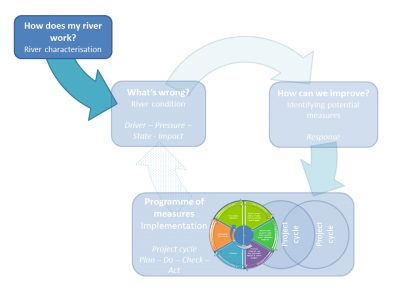Difference between revisions of "How does my river work?"
(→Ecosystem services) |
|||
| (3 intermediate revisions by the same user not shown) | |||
| Line 1: | Line 1: | ||
| − | |||
| − | |||
__NOTOC__ | __NOTOC__ | ||
[[File:Base_structure_wiki_box_1.PNG|thumb|400px|right|link=What's_in_this_wiki?|What's in this wiki? Click image to return to the overview of river basin management plan.]] | [[File:Base_structure_wiki_box_1.PNG|thumb|400px|right|link=What's_in_this_wiki?|What's in this wiki? Click image to return to the overview of river basin management plan.]] | ||
| Line 7: | Line 5: | ||
<br /> | <br /> | ||
=== [[:Category:River_Characterisation|Hydromorphology]] === | === [[:Category:River_Characterisation|Hydromorphology]] === | ||
| − | + | Systematic hydromorphological characterization of a river helps in understanding how rivers respond to pressures and measures at different scales in time and space. REFORM developed a [[Introduction_to_characterisation:_Multi-scale_Hierarchical_Framework|multi-scale hierarchical framework]] for this. We give an overview of the method and show example case studies in which the framework is applied.<br /> | |
| − | + | ||
| − | + | ||
| − | + | ||
| − | + | ||
<br /> | <br /> | ||
=== [[Role_of_vegetation|Role of vegetation]] === | === [[Role_of_vegetation|Role of vegetation]] === | ||
| − | + | Vegetation does not just depend on hydromorphology. It influences hydromorphology too and plays an active role in shaping a river. This section focuses on the reciprocal relations between hydromorphology and vegetation. Understanding these relations can be a major factor in the success or failure of restoration projects.<br /> | |
<br /> | <br /> | ||
=== [[:Category:Ecosystem_Services|Ecosystem services]] === | === [[:Category:Ecosystem_Services|Ecosystem services]] === | ||
| − | + | A river forms an ecosystem that can be made suitable for many human uses. We call these uses “ecosystem services” as they are provided by the ecosystem. This section describes REFORM's results to valuate the services in a river system so we can assess the effects of river restoration on the services provided. | |
| − | + | ||
<br /> | <br /> | ||
Latest revision as of 13:03, 18 December 2018
Knowing how a river works is essential for achieving success in river restoration. It should be the first step in any restoration process, and the basis for any future river basin management plan. Important aspects are hydromorphology (river characterization), the role of vegetation, and ecosystem services.
Hydromorphology
Systematic hydromorphological characterization of a river helps in understanding how rivers respond to pressures and measures at different scales in time and space. REFORM developed a multi-scale hierarchical framework for this. We give an overview of the method and show example case studies in which the framework is applied.
Role of vegetation
Vegetation does not just depend on hydromorphology. It influences hydromorphology too and plays an active role in shaping a river. This section focuses on the reciprocal relations between hydromorphology and vegetation. Understanding these relations can be a major factor in the success or failure of restoration projects.
Ecosystem services
A river forms an ecosystem that can be made suitable for many human uses. We call these uses “ecosystem services” as they are provided by the ecosystem. This section describes REFORM's results to valuate the services in a river system so we can assess the effects of river restoration on the services provided.
